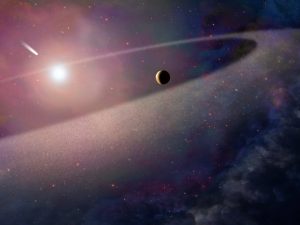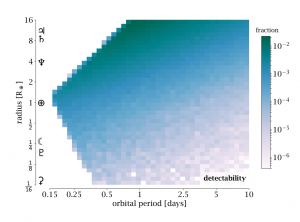Can a White Dwarf Become a Star Again
Title: On the detectability of transiting planets orbiting white dwarfs using LSST
Authors: Jorge Cortes, David K. Kipping
First Author's Institution: Columbia University, New York, U.s.
Status: Submitted to MNRAS, open access
Do white dwarfs have planets? The curt answer is yes—but they're difficult to detect by the traditional methods people use to look for exoplanets. In the next decade this might change cheers to a ground-breaking projection chosen the Large Synoptic Survey Telescope, or LSST. Today's newspaper uses simulations to gauge what LSST will see.
White dwarfs with planets
White dwarfs are dead stars. When a star approaches the finish of its lifetime, information technology swells into a red giant. In a few cases, this volition atomic number 82 to a supernova explosion—merely 95% of all stars will never accomplish the conditions you demand for a supernova. Instead, once these stars take exhausted their fuel, they stop nuclear burning and plummet down, shedding the outer layers of their atmosphere as they do and then. What's left is a white dwarf: a hot, dense ball of spent stellar fuel (in most cases a mixture of carbon and oxygen). These stars are roughly the size of the Earth, but have an boilerplate mass of 60% the mass of the sun.

Effigy 1: Creative person'south impression of a white dwarf with an orbiting planet. Credit: NASA, ESA, and Z. Levy (STScI)
So, can a white dwarf take its own planets? One might expect that this would be incommunicable. It'southward tempting to retrieve that as a star swells and then collapses, whatever planets nearby will either exist swallowed up during the behemothic phase or their orbits will become unstable every bit the star loses mass. Despite this, at that place is testify that a significant number of white dwarfs are orbited by modest, planet-like objects. About i third of white dwarfs show traces of stone-forming elements in their atmosphere, which nosotros believe must have recently landed on the surface of the white dwarf. Some are also surrounded by discs of rubble, thought to exist planets that have passed too close to the white dwarf and broken autonomously. For one white dwarf, WD1145+017, we've actually detected lumps of rock passing between us and the white dwarf, which are idea to be fragments of an exoplanet which recently bankrupt upwards. (Figure 1 is an artist's impression inspired past a few of these detections.) However, we've never detected an entire exoplanet, ane that isn't in the procedure of breaking apart.
Part of the reason for this is that the traditional methods of searching for exoplanets, such as the transit method, don't piece of work too well with white dwarfs. A 'transit' is when an object passes between united states of america and a star, blocking some of its light. Thousands of exoplanets have been found by looking for these transits. However, merely 1 white dwarf shows similar transits, and that is WD1145+017 with its lumps of broken-up rock. The problem comes because white dwarfs are small—about i hundredth the diameter of the Sun. The smaller the star, the less likely a transit is to happen, and so there might be thousands of white dwarfs with unseen planets for every planet y'all could detect.
How a new telescope can alter things
All this might alter with a new project, the Big Synoptic Survey Telescope. The LSST is a telescope being congenital in Chile, due to starting time operation in the early 2020s. It volition survey the visible heaven every few days, and it will observe many thousands of times the number of stars whatsoever comparable survey has institute. It is expected to see some ten million white dwarfs.
Today'south paper investigates how many white dwarf transits we tin expect LSST to see. Specifically, the question they inquire is this: for a given prepare of properties (white dwarf size and effulgence, planet size and orbital period), how likely is information technology that the planet will be found past LSST? They divide this question into two parts. Firstly, how probable is it that the planet will transit the white dwarf, and secondly, if it does, what is the probability that LSST will detect it?
The authors begin with the second role of the question. To answer it, they run iii.5 million simulations of what LSST would meet for different combinations of white dwarf and planet parameters. In each case, they calculate whether the transit would be clear enough to be visible, and count upward the fraction of the full number where we would see it. An instance of the kind of transits that they are looking at is shown in Figure 2.

Figure 2: Simulated plots of measured white dwarf brightness confronting time, as would be seen by LSST, for one set of white dwarf and planet parameters. Each row corresponds to a different filter, with the lower row including observations in all colour bands. Panels on the left testify information over the whole 10-year LSST ascertainment period. The right panels show all data points that autumn nearly a transit. Source: Figure 2 in today's paper.
They next looked at the offset part of the question: for a given set of white dwarf and planet parameters, how probable is information technology that a transit will happen at all? This is a much easier question to reply, equally it comes downward to a uncomplicated geometry question: how large is the white dwarf, how big is the planet, and how far apart are they? One time the probability of a transit has been calculated, the authors combined this with the probability that the transit volition exist detected to produce an overall probability that the system will have a detectable transit. They did this for each gear up of white dwarf and star parameters, as shown in Figure 3.

Figure 3: Detectability of a planet effectually a white dwarf as a function of planetary radius and orbital menses. Darker colours correspond to planets more likely to be detected. More often than not larger planets and shorter orbital periods are easier to detect. The white patches on the left are regions of parameter infinite where planets would be disintegrated by the white dwarf's gravity. Symbols down the left bear witness the radii of Jupiter, Saturn, Neptune, Earth, the Moon, Pluto, and Ceres.Source: Figure 3 in today'due south paper.
The results they find are that almost planets volition not exist detected, which is unsurprising: planets around white dwarfs are every bit hard to observe as ever. Nearly iv in every thousand Earth-sized planets are detectable, and information technology becomes much harder if the planets are smaller. However, the sheer number of LSST targets comes to the rescue here. LSST will find 10 1000000 white dwarfs. Based on the evidence we talked about above, such equally the white dwarfs with rocky elements in their atmosphere, let'due south presume that nigh x% of these white dwarfs host planets. From today's paper, we would expect to discover a number of these planets in transit, and the number might exist equally high as several hundred if the planets are World-sized. Given that but ane transiting white dwarf system is known at the moment, this will exist a huge increase that hopefully will teach united states a lot almost these systems.
LSST is due to start operation in a lilliputian over four years, and this is just 1 example of the revolutionary science it will make possible. Keep an eye out for more!
- Nigh the Author
Source: https://astrobites.org/2018/10/04/lsst-wds/
0 Response to "Can a White Dwarf Become a Star Again"
Post a Comment